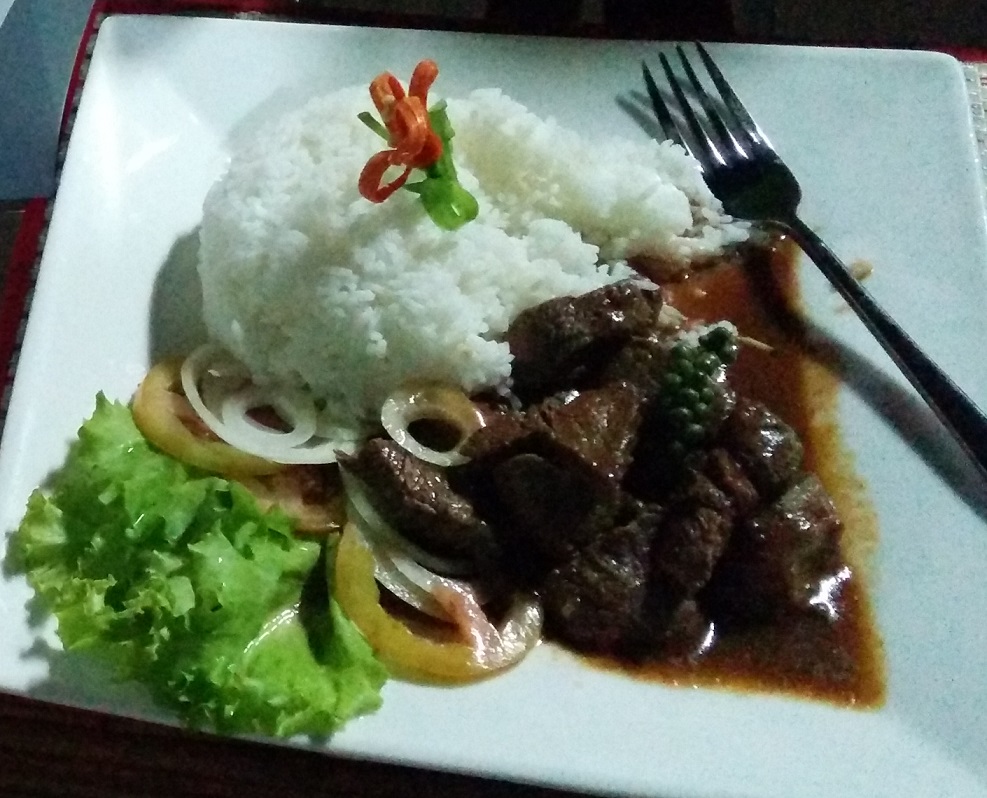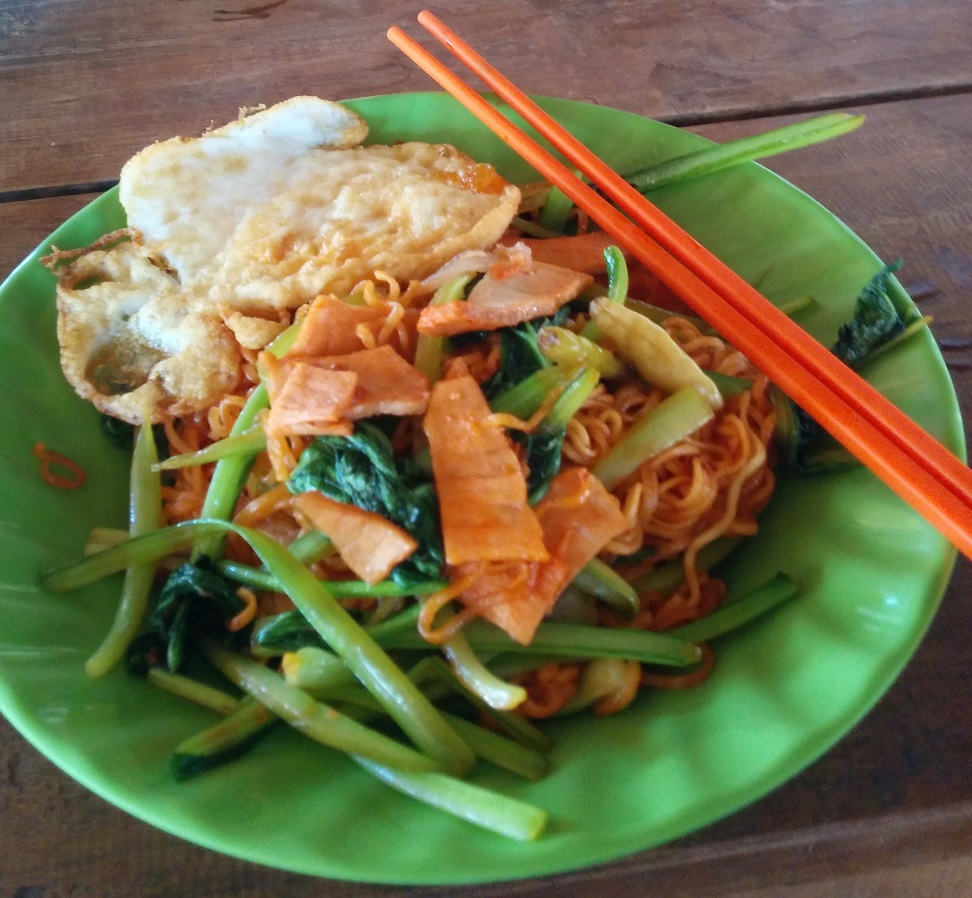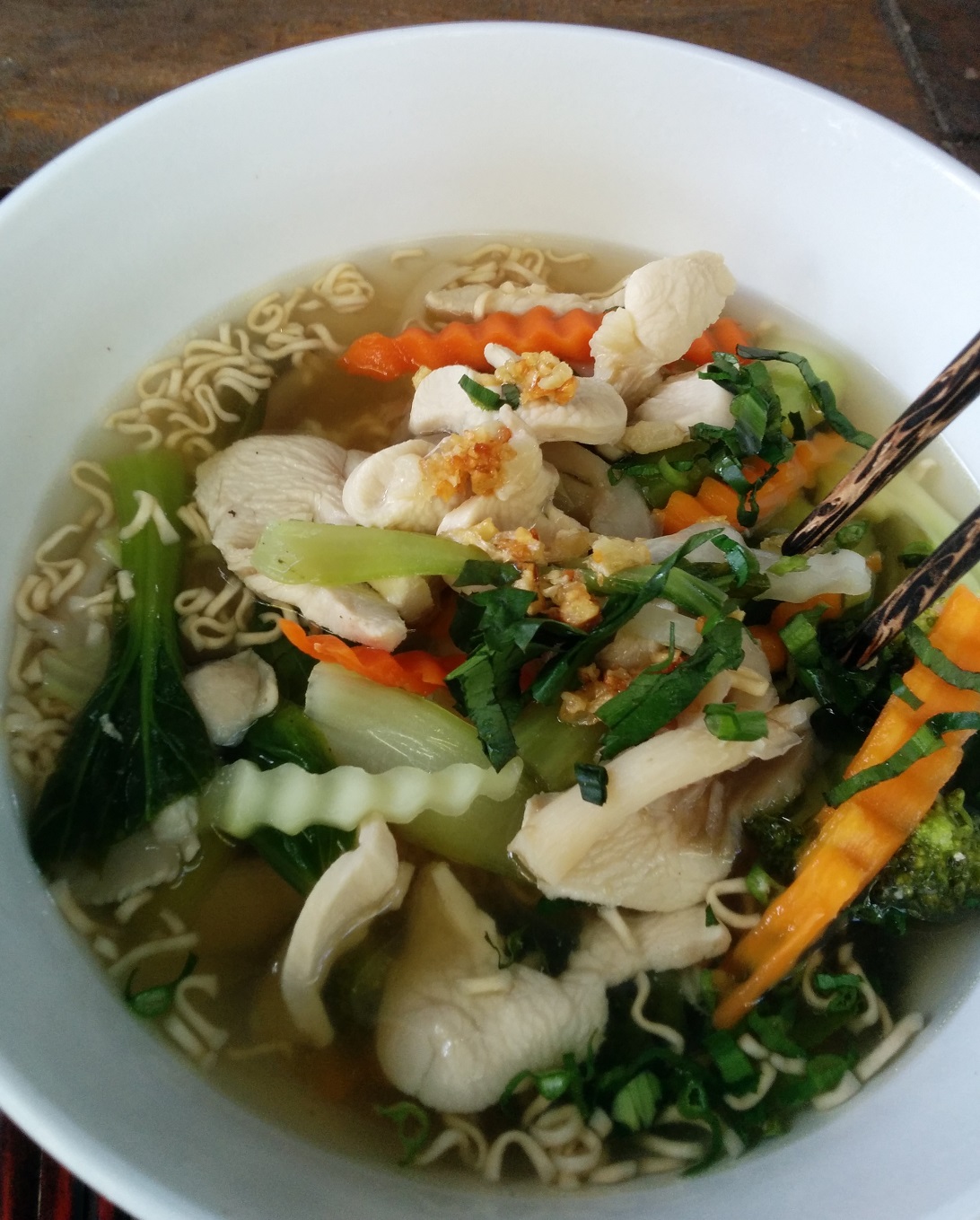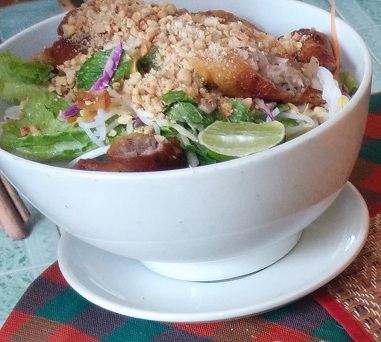Cambodian cuisine revolves heavily around rice, as in multiple countries in this part of the world. Someone explained to us that the rice is considered the ‘main,’ and then small quantities of vegetables and meats in sauces are added, just to help you eat the rice. Rice noodles are also quite prevalent.
 Lok lak (pictured): This is sliced, marinated beef pieces in a delicious sauce, usually served with rice. It’s delicious, and looks eminently familiar to Westerners. Some locals eat the beef in lettuce leaves, like a wrap.
Lok lak (pictured): This is sliced, marinated beef pieces in a delicious sauce, usually served with rice. It’s delicious, and looks eminently familiar to Westerners. Some locals eat the beef in lettuce leaves, like a wrap.- Amok: This is a type of curry, traditionally cooked with fish. Sometimes, it includes vegetables, and its level of liquidiness varies. The internet says that it’s made of coconut milk; curry paste that includes lemongrass, turmeric, garlic, shallots, and Chinese ginger; and a local herb called slok ngor. People who write for tourists would say this is the #1 Cambodian ‘authentic’ dish to try. I doubt that locals would agree.
- Cambodian BBQ (pictured):
 Though Korean BBQ is the more world-famous cuisine, we saw significantly more BBQ restaurants in Cambodia than in Seoul. Basically, they bring you raw meat and vegetables, and you grill in them in butter on a tabletop grill cooker. There’s a second type of BBQ that is popular at markets: you pick various meats (that look like desserts, often!) on kebabs, and the vendor grills it for you.
Though Korean BBQ is the more world-famous cuisine, we saw significantly more BBQ restaurants in Cambodia than in Seoul. Basically, they bring you raw meat and vegetables, and you grill in them in butter on a tabletop grill cooker. There’s a second type of BBQ that is popular at markets: you pick various meats (that look like desserts, often!) on kebabs, and the vendor grills it for you. - Khmer curry: These red or green curries are like the more-famous Thai versions, but with less chili/spice.

- Fried rice (bai cha): Vegetable and chicken or pork fried rice is common. Sometimes, it doesn’t even have veggies, but just a sauce.
- Fried noodles (mi char) (pictured): This is a bunch of yellow (rice) noodles fried with vegetables, usually with a fried egg on top. Various meats can be mixed in.
- Noodle soup (kuy teav) (pictured):
 This is broth, with a bunch of ramen-like noodles in it, along with vegetables – and usually either shrimp or chicken. It tastes a lot better than ramen though, and it’s usually eaten for breakfast.
This is broth, with a bunch of ramen-like noodles in it, along with vegetables – and usually either shrimp or chicken. It tastes a lot better than ramen though, and it’s usually eaten for breakfast. - Nom ban chok: This is a pile of thin, white (rice) noodles, with cucumber, mint, scallions, nuts, and either a sweet or a savory coconut-based curry sauce. It is most often served for breakfast, or occasionally for lunch.
- A nom ban chok-like dish (pictured):
 This is similar to nom ban chok, in that it’s white (rice) noodles with nuts and scallions. It also includes a cut-up fried spring roll or two, meat (though you can get it without), and a clearer-looking, sweeter sauce.
This is similar to nom ban chok, in that it’s white (rice) noodles with nuts and scallions. It also includes a cut-up fried spring roll or two, meat (though you can get it without), and a clearer-looking, sweeter sauce. - Rice porridge (bobor): This reminds me of Russian rice kasha (in its sweet variety) and more like polenta or semolina in its savory variety (I imagine, since I haven’t tried it). The sweet kind includes palm sugar syrup (that looks like caramel) and local fruit for toppings. It’s eaten for breakfast.
- Pork and rice (bai sach chrouk): This is another breakfast dish. Usually, the pork is marinated, barbecued, and sliced thinly over the rice. This also gets some scallions, daikon, pickled mango, etc.
- Morning glory: This is a green vegetable that reminds me of a cross between green beans and brocollini, with a mild flavor. It’s most often served fried, but can also be added to soups or stir fries.
- Sour soup: This has been on a lot of local menus, though we have yet to try it.
 Crab (kdam chaa – the fried version) (pictured): In the south – especially near Kep, they pluck crabs out of the water for you. They shock boil them and then serve them with a pepper/lime sauce. There’s also a fried version.
Crab (kdam chaa – the fried version) (pictured): In the south – especially near Kep, they pluck crabs out of the water for you. They shock boil them and then serve them with a pepper/lime sauce. There’s also a fried version.- Crepes and baguettes: The French influence is evident here, with these bread-y things available in many places. We read that locals dip baguettes in the nom ban chok sauce to sop it up, but I personally never saw a local eating either of these things. I presume they are mostly for tourists.
- [Dessert] Fried bananas: This dessert is made of flat slices of banana, fried in fairly tasteless dough. It was too much dough for my taste, but it’s quite popular here.
 [Dessert] Pumpkin custard (num sang khya l’peou) (pictured): This dessert is made of local pumpkins (which resemble kabocha squashes), egg, palm sugar, coconut milk, and sometimes tapioca balls.
[Dessert] Pumpkin custard (num sang khya l’peou) (pictured): This dessert is made of local pumpkins (which resemble kabocha squashes), egg, palm sugar, coconut milk, and sometimes tapioca balls.- [Snack] Peanut Brittle Squares: They make these sheets of something like peanut brittle, with honey and sesame seeds – and they cut them into squares to sell. They are very delicious.
- [Drink] Coconut: The most common drink here is a big coconut. I detest American coconut drinks, but I love these; they taste nothing alike, in my opinion. Some of the coconuts have pulp you can eat on the inside, and that’s delicious too.



Pingback: Secrets of the Trade - Novelty Buffs